Three goals off the bench at Rangers provide a reminder where Mohamed Salah‘s very best traits lie. It has been the suspicion since the first game of the tactical tweak, but now it’s clear: Mo needs to move into the front line.
You’ll already have seen quite a few stats about Salah’s hat-trick cameo against Rangers, of course. But here are a few more anyway.
First, 2.25. That’s the number of touches of the ball Mo took, per shot he took. In case you didn’t realise, he was keen to have a go.
Then, 100 percent. That’s the shots-to-shots-on-target ratio he managed in his short time on the pitch.
And finally, 1. The number of games this season where he has had more shots than he did in his 23 minutes at Ibrox (four).
The latter is a particularly notable one, despite it sounding dull.
Last season, Salah took the most shots per 90 minutes (ie, average shots per full game) out of any Premier League player who featured in at least nine fixtures, averaging 4.5.
In other words, his performance against Rangers and the efforts he had on goal would have been below his usual standard, normal given he came on as a substitute.

Except, this term, his attacking flurry has bucked the trend.
Only once has Salah taken five shots, against Brighton, with his shots per 90 count in league play standing at three.
Again, 1.5 shots a game doesn’t sound like that much of a drop-off, but it’s 33 percent fewer scoring chances for our best goalscorer, each and every game. In a cumulative sense, it’s enormous.
That current shot rate ranks him 28th (against players with at least four appearances), below the likes of Gabriel Martinelli, Rodrigo or James Maddison.
More pertinently, it also ranks him below Fabio Carvalho, Roberto Firmino and Darwin Nunez, who sits top of that particular ranking.
Threes and fours
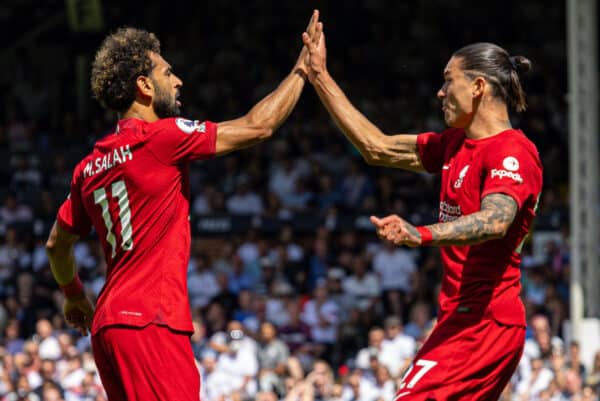
It was quite clear from the outset of the season that someone’s plan had been to use Salah more as a build-up player, a playmaker, than an end-product finisher.
His starting position was a lot wider, he wasn’t running behind the defence as much, and the diagonals pinged out to him were more often than not touchline-based, rather than off the defender’s shoulder.
In and of itself, this is nothing new and not a problem – Salah is a superb outlet and an elite chance-creator for others.
The only real drawback, however, is a big one: the flow of play, the plan or the overall drop-off from the Reds hasn’t allowed Salah to get into enough good shooting positions himself – and that was when we were still playing 4-3-3.
Salah’s role now, in Klopp’s 4-4-2, is even more restricted in some phases of play – he has to stay deeper and wider, because as much as we’d love it to be the case, Liverpool simply aren’t playing well enough to hold a line of four forwards standing around waiting for the rest of the team to give them the ball. The wide players are part of the midfield now, out of possession.
In truth, the refinement and narrow-focusing of Salah’s game has been a constant trend over the last five years, which you’d generally expect as both the individual improves and the team becomes more cohesive, more tactically refined:
2018/19:
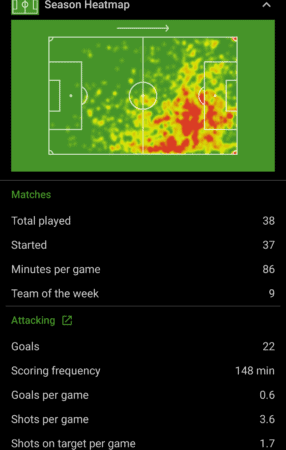
2019/20:
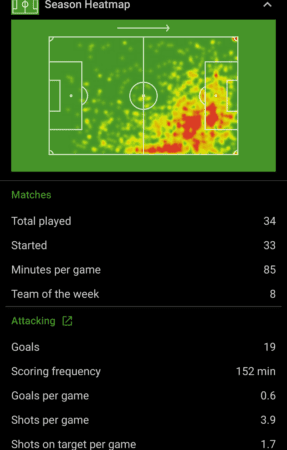
2020/21:
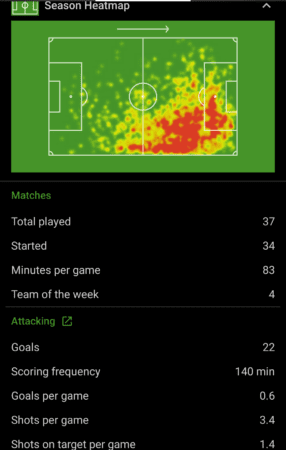
2021/22:
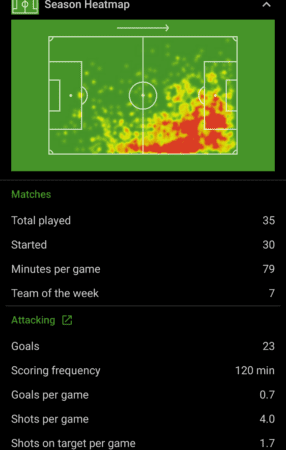
2022/23, so far:
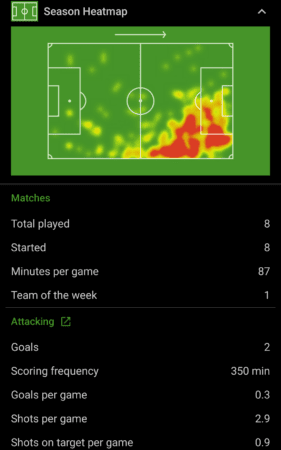
You’ll note that his shots per game rate has remained consitently around 3.5-4 every game, up until this year.
In case you can’t be bothered to work out the shots-to-shots-on-target rate, in season order it is 47 percent, 44 percent, 41 percent, 43 percent… and 31 percent.
We don’t need to go into xG to suggest he’s been taking on lower-quality shooting chances this season, and fewer of them too.
If Salah persists on the right of a four in midfield, then if and when the Reds return to their former dominant selves, the right-sided winger/forward will, of course, be heavily involved in build-up play.
He might even get into more shooting positions – good ones – than he has so far.
But it still won’t be getting the most of him in a final-third sense as we could be, simply by virtue of the role demanding more tracking back, protecting the full-back, and a narrower and deeper starting off-ball position, as he doesn’t have an extra No. 8 behind him doing that.
Into the attack

Take the Arsenal game as a reasonable example. We’re still dealing with a small sample size at the moment in the 4-4-2, but that was a pretty big game for Liverpool given the context of the season.
Ideally, in said big games, you want your big players to have a big impact.
Salah was pretty marginalised, playing 69 minutes before being substituted from the match.
A look at his attacking output tells the story of how the role absolutely did not suit him in terms of getting his best work as a ‘forward’ in the team:
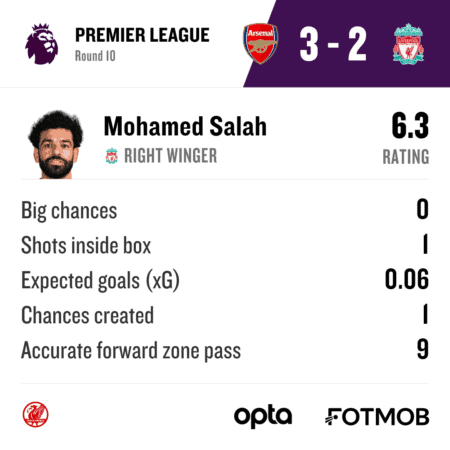
And yet, had any other player picked up these ‘midfield’ numbers, it possibly would have been seen as a pretty normal, fine game, one where they could stay on and be solid, or be subbed off and try to force a change.
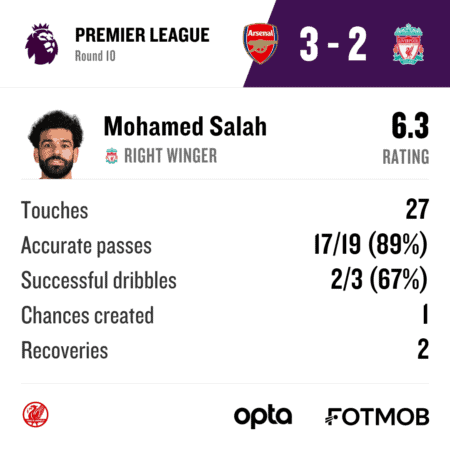
Again, it’s not so much Salah being a problem on the right in this set-up as much as it gets nowhere near enough out of his unbelievable ability levels.
We have the league’s best goalscorer and playmaker over the last few seasons, and now a set-up which has two centre-forwards in it with the mandate of being mobile, working the channels, dropping in defensively and linking up with regularity.
Sorry-not-sorry to point out the obvious but it seems tailor-made for Salah.
He has played the No. 9 role previously, of course. He has long been part-playmaker for Liverpool, and arguably too much so far this term.
We all love it when he has put in the 60-yard sprint back to provide cover after a corner leaves us vulnerable, or when he ends up at right-back jockeying to stop a cross.

How Liverpool are currently playing and the demands on the front two off the ball in this set-up, none of that defensive diligence is going to disappear if he moves centrally – it’ll just be done in different, more dangerous areas.
In terms of scoring, no Liverpool fan is trying to make out the Champions League hat-trick is anything more than it was: a world-class player came on against a tired, beaten and distinctly third-tier side. It isn’t about believing Mo will do that against City, then Ajax, and beyond.
It’s more the fact that as we search for balance again, getting the top players Liverpool do have into slightly altered roles which best suit them has to be a priority.
We’ve already seen Jota and Nunez, for example, link superbly in those twin No. 9 roles. The one-touch passing, the running off each other, the instinctive shots.

Jota is now likely needed in a wide role more often, given Luis Diaz’s injury, and Firmino is the man in form in attack this season.
And yet Salah is better than all of them in the penalty box, has been year after year. He’s also better outside the box than most, and this season’s tactical shift was an attempt to get more out of that. But it’s time to acknowledge it hasn’t worked, at least in terms of making the team better overall.
Let Salah loose in the channels, in the box, in the build-up play as a central outlet and quick-linking front man, and we’ll still see the playmaking benefits of the Egyptian King.
But also that lightning-quick instinct to shoot, the unerring composure under pressure and the ridiculous fast feet which have left many a centre-back on his backside over the last few years.
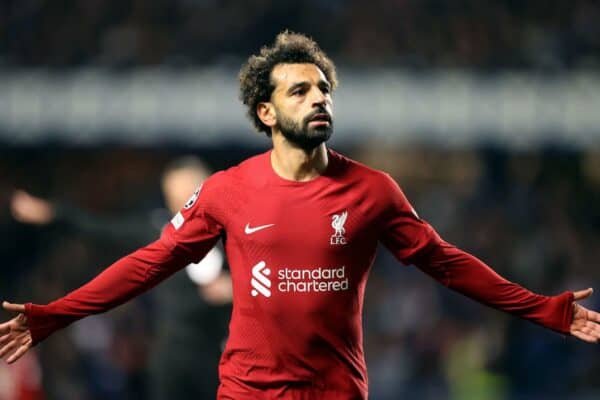


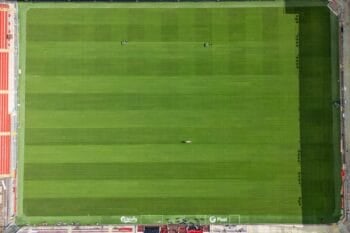
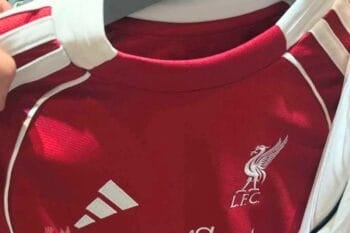

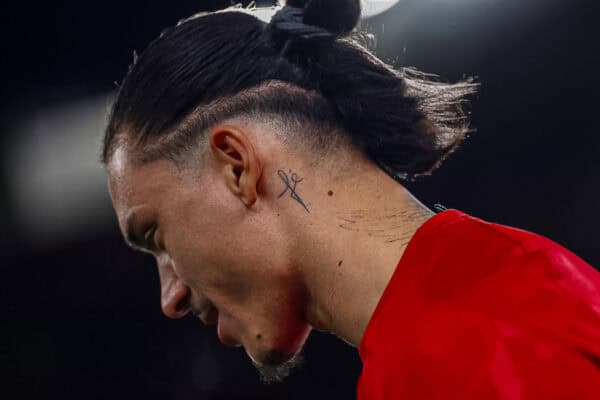
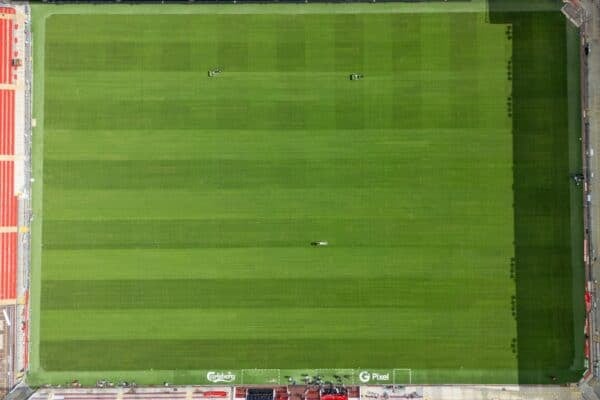
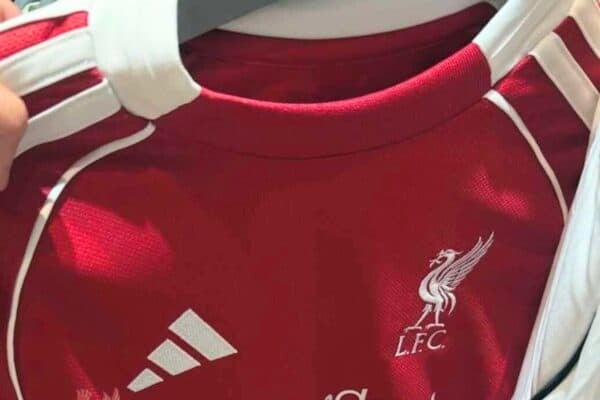

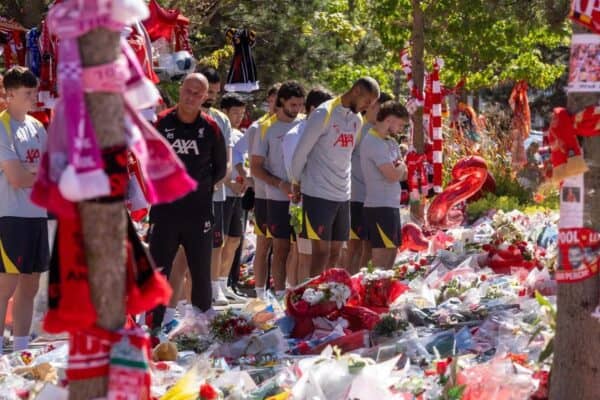








Fan Comments